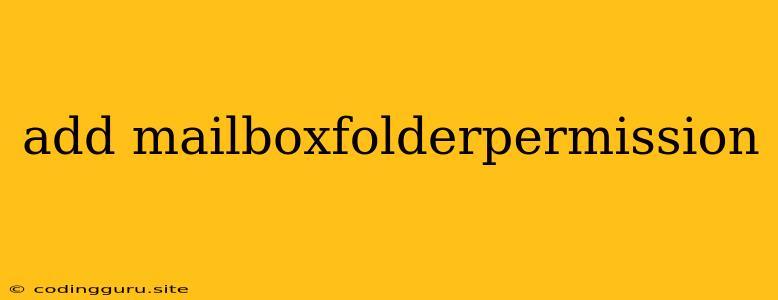Understanding and Managing Mailbox Folder Permissions
In the realm of email management, maintaining control over access to sensitive data is paramount. This is where the add-mailboxfolderpermission cmdlet in Exchange Server comes into play, providing a robust mechanism for managing permissions on mailbox folders.
What is add-mailboxfolderpermission?
add-mailboxfolderpermission is a powerful cmdlet in the Exchange Management Shell that allows administrators to grant specific permissions to users, groups, or other mailboxes on folders within a mailbox. This cmdlet is indispensable for:
- Fine-grained control: It allows you to precisely define who has access to specific folders, ensuring data security and confidentiality.
- Collaboration enhancement: Share folders with colleagues or teams for collaborative projects, enabling efficient access to shared documents and resources.
- Delegation of tasks: Grant limited permissions to assistants or team members to manage specific folders, reducing administrative overhead.
Why is it essential?
The add-mailboxfolderpermission cmdlet is critical because it provides a structured and granular approach to managing access control for email folders. This is crucial for:
- Compliance and regulatory requirements: Many organizations face stringent regulations regarding data privacy and access control.
add-mailboxfolderpermissionhelps ensure adherence to these standards. - Security and data integrity: By controlling who can access sensitive folders, you minimize the risk of unauthorized access and data breaches.
- Efficient team collaboration: Sharing folders with appropriate permissions allows for seamless collaboration without compromising security.
Key Parameters of add-mailboxfolderpermission
The add-mailboxfolderpermission cmdlet employs several parameters to define the specific permissions you want to grant:
- Identity: This parameter specifies the mailbox containing the folder you want to manage permissions for.
- User: This parameter defines the user, group, or mailbox to whom you want to grant permissions.
- AccessRights: This parameter allows you to define the type of access granted, including:
- Owner: Full control over the folder and its contents.
- Editor: Ability to create, edit, and delete items within the folder.
- Reviewer: Ability to view and read items within the folder.
- PublishingEditor: Ability to create and modify items within the folder, but not delete them.
- PublishingReviewer: Ability to view and read items within the folder, and to modify them if they have the appropriate permissions.
- IsInherited: This parameter specifies whether the permissions are inherited from the parent folder.
Practical Example:
Let's say you want to grant a colleague named "John Doe" the ability to read and edit documents in a folder named "Project Documents" within a mailbox named "[email protected]."
add-mailboxfolderpermission -Identity "[email protected]:\Project Documents" -User "John Doe" -AccessRights Editor -IsInherited $false
This command will grant John Doe Editor permissions to the "Project Documents" folder within the "[email protected]" mailbox, ensuring he can access and modify documents within that folder while maintaining the appropriate level of access control.
Tips for Effective Use:
- Plan carefully: Before using
add-mailboxfolderpermission, carefully consider the level of access you need to grant and the specific requirements of your environment. - Use granular permissions: Avoid granting broad permissions if possible, instead, opt for specific access rights based on individual user needs.
- Regularly review permissions: It is essential to periodically review and update mailbox folder permissions to ensure they remain aligned with your organizational policies and security requirements.
- Utilize the
Get-MailboxFolderPermissioncmdlet: This cmdlet allows you to view the permissions currently assigned to a mailbox folder, enabling you to verify and manage permissions effectively.
Conclusion
The add-mailboxfolderpermission cmdlet plays a critical role in managing access control and enhancing security within Exchange Server environments. By understanding its parameters and using it effectively, administrators can establish fine-grained permissions, fostering collaboration while ensuring data confidentiality and compliance with organizational policies.
